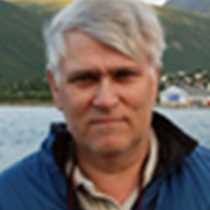Krossfjord, Signehamna & Lilliehööksfjorden
Before we finished breakfast the crew had already arranged for the morning outing. Signehamna in Krossfjorden offers good shelter and protection from wind or swell, and the setting was ideal for both kayaking and Zodiac cruises. Not very far from the ship, the lower parts of the rocky slopes signaled green vegetation, telling us here would be a large breeding colony of seabirds above.
The first to depart from the ship were the hikers, divided into vigorous long hikers, medium, short and a photography walk. As soon as we landed we were able to experience rich vegetation and step on top of the Svalbard forest. We are now well into mid-August and the miniature polar willow (Salix polaris) is less than 2 cm high and has already painted itself into fall colors – red, yellow and brown. The vegetation was also lush with different lichens, yellow, green, black, gray and even white. A closer investigation and we were able to find at least 10 species not seen on our previous outing. As we looked up towards the higher peaks we saw more signs of the oncoming winter, fresh white powder. Fresh snow! Yes, we are in the High Arctic, very close to the North Pole and here summer is very short!
The long hikers made it far into the more rocky area with the goal of locating the remains of one of the top secret German weather bases established in western Spitsbergen during World War II. During the battles of the Barents Sea, the Allies had evacuated Svalbard in August 1941, and the allied Arctic convoys sailed between Iceland and Russia. The German Atlantic fleet, Kriegsmarine, and air force Luftwaffe based in northern Norway were waiting for them. For the German war operations, updated weather forecasts were a necessity to plan attacks on these armadas of ships sailing from Iceland to Murmansk or Archangel loaded with equipment for the Soviets. All together Britain and the US sent out about 40 convoys and many of these ships never made it to Russia.
The German weather station at Signehamna, named Knopse, was established by a German ship Sachsen which brought the team in October 1941. It was later located by a Norwegian patrol based in Isfjorden, at Barentsburg, and attacked. A few days later the German crew was evacuated by the submarine U435. These German submarine captains were absolutely fearless and U435 was the first ever to sail under the Arctic Ocean pack ice. The captain also escaped the British fleet by sailing under the ice through Hinlopen, still today a daring and challenging enterprise. Later the German navy and air force established new weather stations in Liefdefjord, Bjørnøya, Hopen and the northern parts of Nordaustlandet.
The vigorous long hikers made it up into the mountains to find the remains of the station, lots of barrels and rusty metal bars. Scrap for many eyes but here in Svalbard all human artifacts before 1945 are regarded as cultural and historical remains and are not allowed to be removed.
The Zodiac cruisers had a blast with seabirds: Kittiwake young are about to leave their nests and Atlantic puffins are still also feeding their well-hidden chicks. Both Glaucous Gulls and Great Skuas were patrolling the cliffs for potential victims and below the cliff face Arctic foxes were on watch for any young birds fallen from their nests.
During lunch our Captain took National Geographic Explorer into Lilliehööksfjorden and right to the glacier front. Not only a remarkable ice adventure but here we also encountered our last polar bear of the voyage. The bear was swimming along the ice floes, probably trying to find one of the few bearded seals.
During lunch we steamed out into the open sea to set our course for Longyearbyen. A hooded seal was spotted and later a few elusive whales. This remarkable voyage was soon to come to an end and during the Farewell cocktail our Captain closed the journey by presenting many of the crew working behind the scenes to make this operation such a success. Flexibility is the keyword, and we all have seen how much we have been able to gain by constantly searching for wildlife even though we may not end up at the site we had planned. The polar environment is an amazing area to explore.




